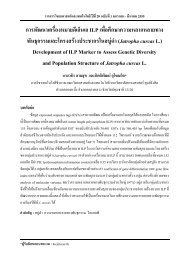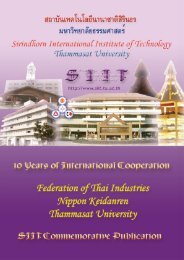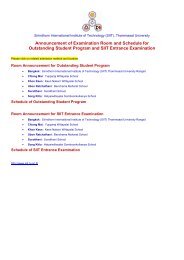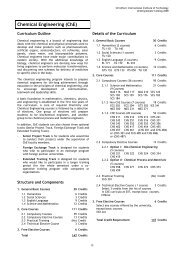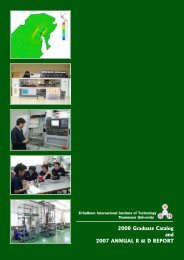2006 Graduate Catalog and 2005 Annual R & D Report - Sirindhorn ...
2006 Graduate Catalog and 2005 Annual R & D Report - Sirindhorn ...
2006 Graduate Catalog and 2005 Annual R & D Report - Sirindhorn ...
Create successful ePaper yourself
Turn your PDF publications into a flip-book with our unique Google optimized e-Paper software.
<strong>2006</strong> <strong>Graduate</strong> <strong>Catalog</strong> <strong>and</strong> <strong>2005</strong> <strong>Annual</strong> R & D <strong>Report</strong><br />
<strong>Sirindhorn</strong> International Institute of Technology (SIIT)<br />
engineering controls, the number of workers <strong>and</strong> their<br />
work assignments for job rotation, <strong>and</strong> the type(s) of<br />
HPDs <strong>and</strong> the worker locations where HPDs are<br />
required. The order of noise control methods<br />
selection will follow the OSHA’s hierarchy of noise<br />
control. The output module will generate a set of<br />
noise hazard control strategies which are effective<br />
(reducing the noise levels at individual worker<br />
locations to 90 dBA or below), fit within the given<br />
budget, <strong>and</strong> are in accordance to the defined budget<br />
allocation. Additionally, for each noise hazard control<br />
strategy, the total cost <strong>and</strong> the noise levels at<br />
individual worker locations will be given to assist the<br />
user in selecting the most preferred strategy.<br />
Workforce Scheduler: An Ergonomic Manpower<br />
Management Tool<br />
This research project is intended to develop a<br />
computerized tool called Workforce Scheduler for<br />
ergonomically managing manpower for a hazardous<br />
work system. A group of industrial workers will<br />
receive daily work assignments to operate/attend a<br />
set of machines/workstations in the workplace where<br />
ergonomics, safety, <strong>and</strong> health hazards are present.<br />
Job rotation will be implemented to alleviate the<br />
workers’ hazard exposures. The types of hazard<br />
considered in Workforce Scheduler include industrial<br />
noise, heat, over-exhaustion, over-exertion, <strong>and</strong> toxic<br />
gases. Workers may be considered as identical or<br />
non-identical receivers, depending on the type of<br />
hazard <strong>and</strong> body tolerance. Workforce Scheduler<br />
allows the user to choose between the single-hazard<br />
exposure option <strong>and</strong> the two-hazard exposure option.<br />
The permissible daily exposure level must be<br />
specified prior to the workforce scheduling.<br />
Workforce Scheduler will determine the daily work<br />
assignment for each worker such that his/her hazard<br />
exposure does not exceed the permissible level.<br />
Additionally, the weekly work schedule for the worker<br />
can be set so that his/her daily hazard exposures for<br />
different workdays will not be the same.<br />
Dr. Veeris Ammarapala<br />
Lecturer (Joined SIIT in August <strong>2005</strong>)<br />
B.Eng. in Industrial Engineering, <strong>Sirindhorn</strong> International Institute of Technology, Thammasat University,<br />
Thail<strong>and</strong><br />
M.Sc. in Operations Research, Columbia University, USA<br />
Ph.D. in Industrial <strong>and</strong> Systems Engineering, Rutgers University, The State University of New Jersey, USA<br />
Areas of Specialization: Decision Support Systems; Risk Management, Economic Analysis.<br />
Research Interests:<br />
Decision Support Systems<br />
Decision Support Systems (DSS) are a specific class<br />
of computerized information system that supports<br />
business <strong>and</strong> organizational decision-making<br />
activities. A properly designed DSS is an interactive<br />
software-based system intended to help decision<br />
makers compile useful information from raw data,<br />
documents, personal knowledge, <strong>and</strong>/or business<br />
models to identify <strong>and</strong> solve problems <strong>and</strong> make<br />
decisions.<br />
Risk Management<br />
Risk is the net negative impact of the exercise of<br />
vulnerability, considering both the probability <strong>and</strong> the<br />
impact of occurrence. Risk management is the<br />
process of identifying risk, assessing risk, <strong>and</strong> taking<br />
steps to reduce risk to an acceptable level.<br />
It is critical for any organization to establish a<br />
foundation for the development of an effective risk<br />
management program, containing both the definitions<br />
<strong>and</strong> the practical guidance necessary for assessing<br />
<strong>and</strong> mitigating risks identified within the organization.<br />
The ultimate goal is to help organizations to better<br />
manage mission-related risks.<br />
Economic Analysis<br />
Economics is a social science that typically studies<br />
the production, distribution, <strong>and</strong> consumption of<br />
goods <strong>and</strong> services. Economic logic is increasingly<br />
applied to any problem determining economic value<br />
(such as politics, religion, psychology, history <strong>and</strong><br />
engineering).<br />
Economic analysis is a systematic approach to a<br />
given program, designed to assist the management in<br />
solving a problem of choice. The full problem is<br />
investigated. Objectives <strong>and</strong> alternatives are<br />
searched out <strong>and</strong> compared in light of their benefits<br />
<strong>and</strong> costs through the use of an appropriate analytical<br />
framework.<br />
31




